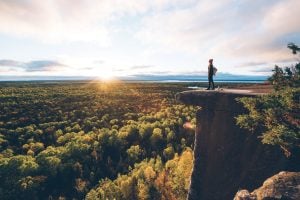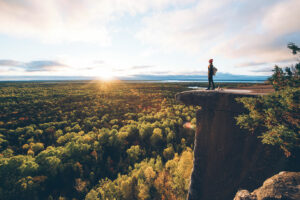
Travel
How to stop a gold rush
The new movement building flourishing tourism hubs across Canada – one sustainable example at a time
- 3297 words
- 14 minutes
This article is over 5 years old and may contain outdated information.
Wildlife

There is more than one way to shoot a bear. A new study has discovered that focusing a camera on iconic species, like the ghostly kermode spirit bears of the Great Bear Rainforest, is substantially more profitable than aiming a rifle.
The Center for Responsible Tourism in Washington, D.C. released a report that says tourism companies focused on bear-viewing and photography trips along the British Columbia coast generate more than 12 times as much in visitor spending as bear-hunting outfits.
The report notes that viewing generated $15.1 million, while guided resident and non-resident hunting generated $1.2 million. It also found that hunting has decreased in the Great Bear Rainforest, making for increased opportunities for wildlife watching.
Chris Darimont, a Hakai-Raincoast Conservation scholar and geography professor at the University of Victoria, says an organization called Raincoast Conservation Foundations has even bought out a hunting outfit and now offers exclusive rights to ecotourism groups, like Maple Leaf Adventures.

He says that hunting and ecotourism cannot coexist; although taking a few bears may not seem to matter in the grand scheme of things, it would disrupt the predictable bear-watching situations that tour companies rely on. But the ways some bears are reacting to bear-viewing is remarkable. He says that mothers are sometimes leaving their cubs near tourists for bear-sitting purposes while they go off to fish. It’s almost as if a sort of trust has developed.
The Great Bear Rainforest has a variety of wildlife and provides a spectacular opportunity to see any number of species, including bears, wolves, cougars and songbirds. Although the reasons are complex for so much wildlife diversity, the yearly salmon run up in the area may have something to do with it. Darimont says that bears act like “the gardeners” of the rainforest. They eat massive quantities of the fish, dragging them out of the creeks and abandoning them in the bush.
The rest of the half-eaten carcasses, or “sacks of fertilizer or food” as Darimont calls them, are consumed by other carnivores or eventually absorbed by the surrounding plants and flora. He says the salmon essentially sustains trees, shrubs, invertebrates and plenty of maggots, which in turn feed songbirds and amphibians.
Another recent study in the news shows that even the elusive wolverines have invited themselves to the all-you-can-eat sashimi buffet. Although Darimont says that First Nations groups in the area have known for years that the animals sometimes descend from the mountains to dine on salmon, the report has found the first documented evidence that at least two of the animals now live on Princess Royal Island — usually a kermode stronghold.
If you’re interested in seeing wolverines and bears in the Great Bear Rainforest, check out the Canadian Geographic/Maple Leaf Adventures expedition that is taking place this summer.
Are you passionate about Canadian geography?
You can support Canadian Geographic in 3 ways:

Travel
The new movement building flourishing tourism hubs across Canada – one sustainable example at a time

Wildlife
An estimated annual $175-billion business, the illegal trade in wildlife is the world’s fourth-largest criminal enterprise. It stands to radically alter the animal kingdom.

Travel
Un nouveau mouvement créateur de pôles touristiques florissants dans tout le Canada – la durabilité, un exemple à la fois

Wildlife
Wildlife photographers on the thrill of the chase — and the importance of setting ethical guidelines